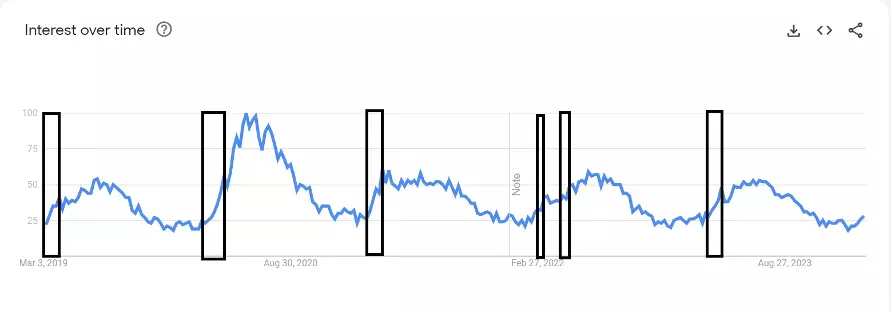Why Seasonal SEO Matters
Here’s how to utilize seasonal SEO to improve organic visibility for seasonal products or services at precisely the right time.
Seasonal keywords are an outstanding opportunity to create season-specific organic content that capitalizes on data-driven consumer behavior. Seasonal keyword variations are key differentiators for e-commerce brands, multichannel retailers, and professionals with annual or recurring services like tax preparation.
Here’s how it works …
Always On Time and on Topic, with Seasonal SEO
Seasonal SEO uses many general SEO strategies and focuses on time or events. Brands offering products or services with even small degrees of seasonal demand fluctuation benefit from targeting time-based or event-based terms.
Get to know the two different keyword types for seasonal SEO:
- Time-based keywords: These focus on seasons or months, including the holidays. SEO keywords for time-centric terms might include “spring tune-ups,” “winter warm-ups” or even more specific terms like “new year’s resolution sale.”
- Event-based keywords: These keywords focus on a specific holiday, like Christmas or a well-established event like Black Friday. They might also add a geo-modifier, such as “black friday deals in traverse city.”
How to Find Seasonal SEO Keywords
There are several tools to help you find seasonal keywords relevant to your brand. We’re big fans of the SEO tool Semrush (a fee-based tool for professionals), but there are a few other very useful free tools as well to get you started.
Google Trends
Look at your products or services and list 5-10 terms you know that have a degree of seasonality. You can adjust the sample period back a full two decades (five years is usually plenty) and look at when interest peaks and declines. Here’s a look at “bike repair” over the past five years:

As you might expect, in the north, the demand for bike repairs increases in the spring as the weather improves. This is valuable information for brands looking to use seasonal keywords for organic and paid campaigns by targeting terms like:
- spring bike tune up – 20 US-based Google searches per month
- spring bike tune up checklist – 10
- mountain bike spring tune up – 10
- road bike spring tune up – 10
Google Search Console
Another free tool from Google, Search Console (GSC) shows how your site performs on the search engine results page (SERP). In addition to tracking your site impressions and clicks, you can also see which search queries are getting eyes on your site’s links.
To make the most of your data, try these steps:
- Use the data you found in Google Trends and filter the queries in GSC to that specific period.
- Boil the data down to the set period, then see which queries topped the charts by impressions and clicks. Check out our example in the chart above! We added a few black boxes on the most pronounced search volume increases.
- Export that data into a spreadsheet and remove branded terms.
Sure enough, some of the top terms for our bike shop example were:
- spring bike sale
- spring bike tune-ups
- spring mountain bike race
Interestingly, this bike shop ranks outside the top 20 positions for all three terms! That’s an opportunity to optimize our use of these terms and make a dedicated spring-focused page to capture these and other relevant keywords, such as the names of those spring mountain bike races.
3 SEO Tips for Holiday Sales
For many retailers, a successful holiday sales season is make or break. Online and in-store sales in November and December alone account for about 20% of total retail spending per year, giving the last two months of the year outsized influence on revenue.
For a successful season, invest time researching and implementing the right terms for your business using the tactics outlined above and these helpful tips:
1. Start short, go long.
Expand on short tail keywords to craft more precise queries. Start with a short keyword, then build from there:
- holiday coffee – 590 US-based Google searches per month
- holiday coffee blend – 20
- holiday coffee blend gift basket – 10
2. Time it right.
SEO usually takes two to four months to make an impact, so start your optimizations a few months before the season pops. SEO for the holidays should be researched in June, implemented by July, and firing on all cylinders by October when many consumers start their holiday shopping.
3. It’s never done.
Search engines like Google are constantly adjusting algorithms, and there’s a good chance your competitors aren’t sitting on their hands, either. Make seasonal SEO a part of your team’s year-round optimization strategy to retain position for seasonal keywords and discover new opportunities to win clicks – or let the SEO pros do the digging!
‘Tis the Season to Own the SERP
Seasonal SEO is just one component of a comprehensive digital marketing strategy. Our team works year-round to identify creative ways to improve client results. From consulting and research to full-service marketing support, our integrated SEO, paid media, design and development teams bring experience and enthusiasm to every project.
See what nearly 30 years of institutional knowledge can do for your brand. Reach out today or call (231) 922-9977 to get started.